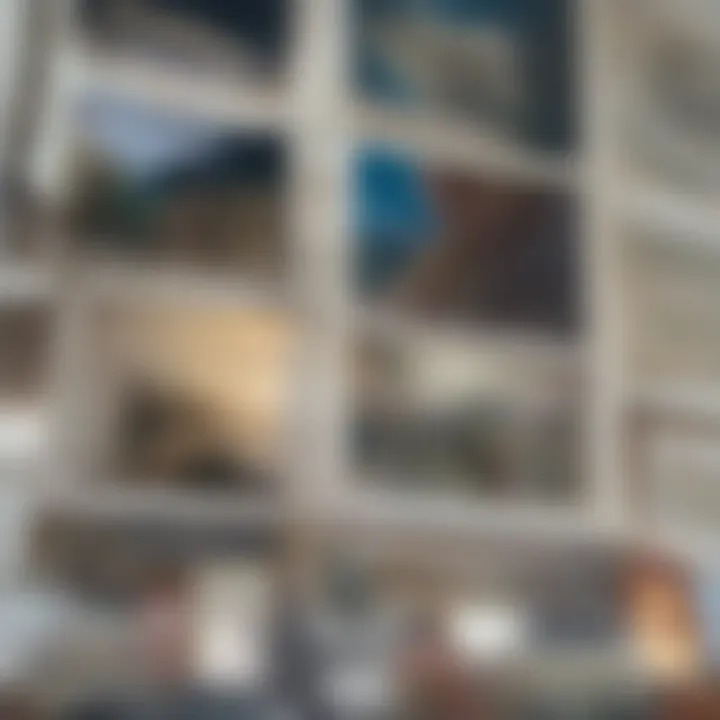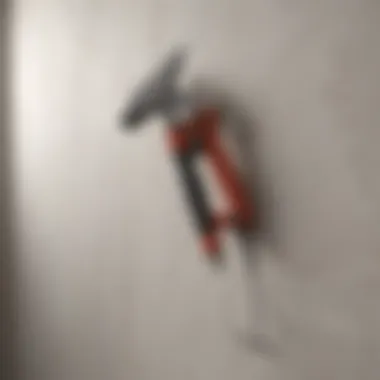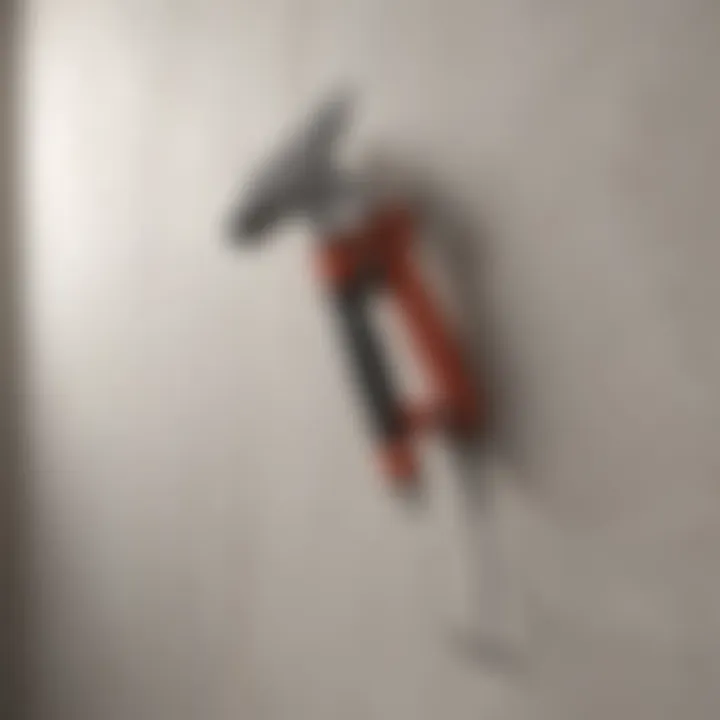Selecting the Best Hangers for Plaster Walls


Intro
Choosing the right hangers for plaster walls is crucial for both functionality and aesthetics. Plaster walls present unique challenges when it comes to hanging items, as they can be fragile and susceptible to cracking. Understanding the various types of hangers available ensures that homeowners can securely mount their artwork, shelves, or other decor without damaging the walls.
In this article, we delve into the essential aspects of selecting the best hangers for plaster surfaces. We will explore the types of hangers suited for plaster, the materials they are made from, and effective installation techniques. Furthermore, we aim to equip design enthusiasts with practical tips to maintain structural integrity and aesthetic appeal in their living spaces.
As we progress, key points will cover:
- Different types of hangers and their uses
- Material considerations for durability and weight capacity
- Installation techniques specific to plaster walls
- Common mistakes to avoid when hanging items on plaster
This guide is specifically tailored for homeowners, interior design aficionados, and real estate enthusiasts, offering insights into achieving a balance between beauty and strength in wall decor.
Understanding Plaster Walls
Understanding plaster walls is crucial when it comes to choosing the right hangers for your wall decorations. Plaster walls are often found in older homes and certain design styles, and they have unique characteristics that set them apart from more contemporary wall materials like drywall. Recognizing these characteristics is essential for successful installation, ensuring that the aesthetics and integrity of the wall are maintained while safely securing your items.
Characteristics of Plaster Walls
Plaster walls are typically made from a mix of gypsum, water, and various additives. They are applied over a wooden or metal lath framework, allowing them to adhere better than simply applying it to a flat surface. This results in several notable characteristics:
- Durability: Plaster is generally more durable than drywall. It offers better resistance to dents and scratches.
- Thermal and Acoustic Insulation: The thickness of plaster provides a level of insulation that can help with both temperature control and sound dampening.
- Finish Quality: The finish of plaster can create an aesthetically pleasing surface that may even improve with age, offering a vintage appeal.
Understanding these traits assists homeowners and designers in selecting hangers that complement plaster's unique structure.
Common Challenges with Plaster Walls
While plaster walls have several benefits, they also come with specific challenges that one must consider. These challenges can complicate the installation of wall hangers, making it necessary to tread carefully. Some common issues include:
- Cracking: Plaster is prone to cracking over time, often due to settling or moisture. This can lead to structural problems if not addressed.
- Weight Limitations: Overloading plaster walls with heavy objects can lead to damage. The hangers selected must be appropriate for the weight of the items being hung.
- Difficult Installation: Drilling into plaster can be tricky. It requires proper tools and techniques to avoid damaging the wall surface.
"Choosing the right hanger for plaster walls isn’t just about aesthetics; it’s about ensuring the structure remains intact and functional."
By recognizing these challenges, one can make informed choices that will allow them to successfully hang pictures and other decorative elements without compromising the integrity of their plaster walls.
Importance of Choosing the Right Hanger
Choosing the right hanger is crucial when dealing with plaster walls. These walls have unique characteristics that unique considerations to ensure both security and aesthetics. The right hanging solution can prevent damage to the wall and maintain the structural integrity of your decor. Durable and well-suited hangers allow homeowners to display their belongings confidently, knowing that they will remain secure.
When the appropriate hanger is selected, it can greatly influence the longevity of both the wall and the item being displayed. Over time, heavy or improperly mounted items can cause cracks or even lead to accidents. In contrast, using suitable hangers allows for a safe environment, limiting potential mishaps. Additionally, the choice of a hanger directly affects how a room feels and looks. A well-selected hanger can enhance the artwork or decor while blending seamlessly into the overall style of the room.
Overall, selecting the right hanger is not just a matter of function; it is also about creating an atmosphere and ensuring safety.
Impact on Wall Integrity
Plaster walls are known for their fragility, which means that the impact of the chosen hanger can be significant. If too much weight is applied to a weaker area of plaster, the wall may crack or chip away. If the installation does not take into account the specific weight distribution, it can compromise the integrity of the wall. Thus, the impact lies tenfold: not only could this lead to expensive repairs but also it could affect the aesthetic quality of your home.
For example, D-ring hangers and picture wire hangers can distribute weight evenly across a wall. Using these types appropriately can protect the plaster beneath from undue stress. It is essential to consider the anchor points to prevent any structural damage when hanging heavier items.
Aesthetic Considerations
The aesthetic dimension is just as significant as the structural one. Hangers determine how items are viewed in relation to the wall. A poorly chosen hanger can detract from the visual appeal of an artwork or display. Hangers can either blend into the decor, enhancing it, or stand out awkwardly, drawing unwanted attention.
When selecting hangers, consider their visibility. For instance, a French cleat system can be ideal for larger pieces of art, keeping the mount hidden, thus maintaining focus on the artwork itself. In contrast, adhesive strips could work for lighter, more modern installations, ensuring a finished look without visible hooks.
In summary, the combination of wall integrity and aesthetic choices underscores the importance of selecting the right hanger. The choices made not only affect individual installations but the overall room ambiance as well.


Types of Hangers for Plaster Walls
Choosing the right hangers for plaster walls is essential for both functionality and aesthetics. The type of hanger impacts how securely items are mounted, how they interact with the delicate plaster surface, and their overall appearance in the space. Each choice offers unique benefits and considerations, making it crucial to understand what works best for specific applications.
D-ring Hangers
D-ring hangers are among the simplest and most effective methods for hanging items on plaster walls. These hangers consist of a metal hoop attached to a small plate, which is affixed to the back of the frame or object being hung.
The primary advantage of D-ring hangers is their ease of installation. They can distribute weight evenly, minimizing stress on the plaster. When securing an item with D-ring hangers, it is advisable to use a sturdy screw that can penetrate deeper into the wall for optimal support. Given their simplicity, they are suitable for various sizes and weights of art pieces, mirrors, and other wall decorations. However, care must be taken to determine the appropriate screw size based on the weight of the item.
Picture Wire Hangers
Picture wire hangers offer another versatile option for mounting framed artwork and other hanging pieces on plaster walls. This method uses a length of wire attached to D-rings or eye screws on either end of a frame. When installed correctly, this method allows the picture to hang flush against the wall.
One of the main benefits of picture wire hangers is their flexibility. They allow for slight adjustments to the positioning of the artwork without the need for new holes. It is important to choose wire that supports the item's weight to ensure stability. Picture wire can also enhance the visual appeal of a hanging piece as it is less visible than traditional hooks.
French Cleat Systems
French cleat systems provide a robust solution for heavier objects. This method consists of two interlocking strips: one mounted to the wall and one attached to the item being hung. The wall-mounted piece is angled, allowing the item to rest securely in place.
The strength and security of a French cleat system make it ideal for larger frames, mirrors, or even shelving. The key advantage lies in the ease of removing or adjusting the item once the cleat is in place. It is crucial to install the wall cleat level to ensure proper alignment of the item. When dealing with plaster walls, using appropriate anchors will help maintain structural integrity while supporting the weight.
Adhesive Strips
Adhesive strips present a non-invasive alternative for hanging lightweight items. These removable products adhere to both the wall and the back of the object. They are especially useful when dealing with rented spaces where drilling holes is not permitted.
Though adhesive strips are convenient, they are best suited for smaller frames or lightweight decor. The main advantage is their easy application and removal without damaging the plaster surface. However, it's essential to check the manufacturer's weight limits to prevent failure.
Wall Anchors
Wall anchors are an essential tool when extra support is required, especially for heavy items on plaster walls. These devices provide additional holding capacity by expanding within the wall when a screw is inserted.
There are different types of wall anchors, including plastic, metal, and toggle bolts. Choosing the right type depends on the item's weight and the wall's structure. It is important to follow installation guidelines for anchors to maximize their effectiveness. Proper use of wall anchors significantly reduces the risk of plaster cracking or failing under weight.
Each type of hanger discussed has its place depending on the project and item being hung. Making an informed decision ensures both functionality and aesthetic value for any space. By selecting the correct hanger, you can ensure that your plaster walls remain intact while displaying your cherished items.
Evaluating Material Options
Choosing the right material for wall hangers is a crucial step when dealing with plaster walls. Each material has its unique set of advantages and disadvantages that can significantly impact both the aesthetic appeal and structural integrity of the installation. Understanding material properties is important because it directly correlates to the longevity of the hanging solution and the safety of the items on display. For plaster walls, proper evaluation of material options is essential for ensuring that hangers can support the weight of the items while minimizing possible damage to the plaster surface.
Metal Hangers
Metal hangers are known for their strength and durability. Made typically from steel or aluminum, they often provide superior weight-bearing capabilities compared to other materials. This makes them an ideal choice for heavier picture frames or art pieces.
Benefits of Metal Hangers:
- Strength: They can support significant weight without bending or breaking.
- Longevity: Metal does not wear out as quickly as plastic or wood, ensuring a longer lifespan.
- Versatile Use: Available in various designs to suit different aesthetic preferences.
Considerations:
- Metal hangers may require precise installation to avoid cracking the plaster.
- Ensure surface protection, as direct metal contact could lead to rust or corrosion over time.
Plastic Hangers
Plastic hangers offer an alternative that is lightweight and often less expensive than their metal counterparts. They come in various styles, including adhesive options and traditional hooks.


Benefits of Plastic Hangers:
- Lightweight: Easy to handle and install, which is beneficial for DIY projects.
- Cost-effective: Generally lower in price, making them accessible for many users.
- Non-corrosive: Unlike metal, plastics do not rust or corrode, which is a plus in humid areas.
Considerations:
- Not as strong as metal, so they are mainly suitable for lighter items.
- Over time, plastic may degrade under UV exposure, affecting performance.
Wooden Hangers
Wooden hangers bring a natural aesthetic to any room. They can vary widely in terms of strength, appearance, and finish.
Benefits of Wooden Hangers:
- Aesthetic Appeal: They provide a warm, classic look that complements many decor styles.
- Strength Variation: Depending on the type of wood, they can support moderate to substantial weight.
- Eco-Friendly Options: Sustainable choices are available, making it an appealing option for environmentally conscious consumers.
Considerations:
- Wood can be susceptible to moisture and may warp or crack under certain conditions.
- Installation may require more care, as improper anchoring can lead to failure under load.
In summary, evaluating material options is a fundamental aspect of selecting hangers for plaster walls. Metal, plastic, and wooden hangers each offer unique benefits and considerations based on weight capacity, appearance, and longevity. It is crucial to match the hanger type with the specific needs of the items to be hung.
Installation Techniques for Plaster Walls
Proper installation techniques are crucial when it comes to hanging items on plaster walls. The nature of plaster materials makes them distinct from drywall, requiring specialized methods to ensure durability and aesthetic cohesion. When applying the right techniques, homeowners can significantly reduce the risks of damage while also achieving a clean, professional look. An effective installation not only supports the weight of the items but also preserves the integrity of the plaster surface, minimizing the potential for cracks or breakage.
Pre-Installation Preparation
Before embarking on the actual hanging process, adequate preparation is fundamental. This phase involves selecting the appropriate site for installation and ensuring the wall is in suitable condition.
- Assess the wall condition: Look for cracks, loose plaster, or other signs of wear. Address any problems first, as they may affect stability later.
- Mark the location: Use a pencil or a chalk line to indicate where the hanger will go. Measuring is essential to avoid misalignment.
- Gather necessary tools: Ensure you have all required tools like a level, drill, and appropriate anchors. The choice of tools can greatly impact the success of the installation.
- Determine weight-bearing needs: Understand the weight of the items being hung. This helps in selecting the right hangers.
This preparatory stage ensures that the process flows smoothly and sets a solid foundation for the installation phase.
Effective Drilling Methods
Drilling into plaster requires a careful approach to minimize damage. Using the correct methods can prevent blasting holes, which can weaken the plaster or create an opportunity for moisture intrusion. Here are some effective drilling methods:
- Use a masonry bit: A bit designed for masonry helps in cleanly penetrating the plaster without chipping. Avoid using standard wood bits, as they can cause more harm.
- Drill at a low speed: High-speed drilling may cause the plaster to crack or chip. A slower speed provides better control and reduces the risk of damage.
- Drilling depth awareness: Be aware of how deep you are drilling. Go just deep enough to accommodate the anchor without going through the wall.
- Utilize a studs finder: This can help identify if there are any hidden studs that can provide additional support.
Employing these methods will ensure that the holes created are tidy and appropriate for the weight being supported.
Ensuring Level Alignment
Proper alignment is crucial for both aesthetic and practical reasons. An item that is not level can appear crooked, detracting from the overall visual appeal of the space. Additionally, misalignment can lead to an uneven distribution of weight, putting unnecessary stress on the wall and the hanger. Here are steps to ensure level alignment:
- Use a level: Always check with a level tool before making holes in the wall. This simple tool allows you to confirm that the item will hang straight.
- Double-check measurements: Measure multiple times to ensure consistency.
- Adjust as needed: If the first attempt does not feel right, do not hesitate to adjust the positions before any drilling.
- Install hangers symmetrically: This can enhance balance and visual harmony of the displayed object.
Ensuring that every piece is aligned not only enhances its appearance but also contributes to its stability and longevity on the wall.
Taking the time to prepare thoroughly, drill appropriately, and ensure accurate alignment can lead to a much-improved experience in hanging objects on plaster walls, contributing to both functional and aesthetic goals.
Load-Bearing Capacity of Hangers
The load-bearing capacity of hangers is a crucial consideration when selecting appropriate tools for plaster walls. Plaster materials differ greatly from drywall in terms of strength and durability. Therefore, understanding the limitations and capabilities of different hangers ensures the safety and aesthetic integrity of your installations.


Hangers are designed to support various weights, and each type is associated with specific load capacities. If a chosen hanger fails to bear the weight of the item hung on it, it can result in damage not only to the item but also to the plaster surface. This could lead to costly repairs or even dangerous situations, particularly if heavy items, like mirrors or shelves, are involved.
When assessing the best hangers for plaster, consider:
- The material and construction of the hanger affect its load-bearing capacity.
- The distribution of weight across the hanger can influence its effectiveness, making some designs more suitable for heavier items.
- Proper installation techniques are equally important; even the best hanger will fail if not installed correctly.
"Ensuring the right hanger is used is essential for maintaining both the look and safety of plaster walls."
Understanding Weight Distribution
Weight distribution plays a pivotal role in how effectively a hanger can support an item. For plaster walls, understanding how weight is distributed can help in choosing the correct hanger. When items are hung on a wall, the weight is not just anchored at one point; it spreads out depending on the design of the hanger and the nature of the object.
For example, a French cleat system helps distribute weight evenly along the wall. This design minimizes stress on any single point, reducing the risk of damage to the plaster. With heavier items, it is particularly vital to ensure that weight is not concentrated in one area. Other factors to consider include:
- The total weight of the item should influence the type and size of the hanger selected.
- For very heavy items, consider using multiple hangers to evenly share weight distribution.
Choosing Based on Item Type
The type of item you plan to hang significantly informs your choice of hanger. Different objects contribute varying amounts of stress on the plaster wall, and they require specific hangers that can handle that load wisely.
- Light items: Artwork and small frames may be adequately supported by adhesive strips or simple D-ring hangers. These hangers are often easier to install and remove without damaging the wall.
- Medium items: For medium-weight objects like shelves, using wall anchors or picture wire hangers is advisable. These allow for a bit more flexibility in weight distribution while maintaining a secure hold.
- Heavy items: When hanging heavier objects like large mirrors or shelving units, using a French cleat system or heavy-duty wall anchors is best. These options provide the strength necessary for substantial support, preventing any mishaps.
In summary, knowing the load-bearing capacity of hangers, weight distribution principles, and item type suitability are key factors in maintaining your plaster walls. Each decision made in this process contributes not only to the beauty of your space but also to its long-term safety.
Maintaining Plaster Walls
Maintaining plaster walls is crucial for preserving their aesthetic and structural integrity. Plaster can crack and become damaged over time due to environmental factors, inadequate installation, or the weight of items hung on them. Regular maintenance helps to identify problems early and prevents more extensive and costly repairs down the line. This section will cover the importance of regular checks and effective repair techniques, ensuring that plaster walls remain resilient and visually appealing.
Regular Checks for Damage
Conducting regular checks for damage is a vital part of plaster wall maintenance. Homeowners should be proactive rather than reactive. Look for cracks, discoloration, or any flaking on the surface. Even small signs can be indicators of underlying issues.
- Frequency of Checks: A good practice is to inspect plaster walls at least twice a year. This regularity can help catch problems before they worsen.
- What to Look For: Pay attention to specific areas where hangers are installed. These points might experience more stress, leading to cracks or other damage. Identifying changes in your plaster can save time and money.
- Documentation: Keep a record of any damage, repair conducted, or adjustments made. This history can be valuable for future maintenance and resale conditions.
"Regular maintenance is the key to longevity in plaster walls. Attention to detail now can save significant effort later."
Repair Techniques for Aged Plaster
Repairing aged plaster is not just about fixing the appearance; it’s about restoring function and durability as well. The right techniques will depend on the extent of the damage. Here are some common strategies:
- Patching Cracks: Use a suitable compound to fill in cracks. For hairline cracks, a simple plaster filler works well. For broader areas, a more robust patching procedure may be necessary.
- Reinforcing Weak Sections: If certain areas show significant signs of weakness, adding mesh tape before applying plaster can help create a more durable surface.
- Skim Coating: For larger areas with extensive wear, consider applying a skim coat. This thin layer of new plaster will revitalize the surface and add a uniform finish.
- Professional Help: If the damage is severe, it might be best to consult with experienced professionals. Their insights can ensure long-term solutions rather than temporary fixes.
Maintaining plaster walls demands ongoing attention. By ensuring regular inspections and applying effective repair strategies, homeowners can safeguard their investment, promote structural health, and enhance the beauty of their spaces.
Finale: Best Practices for Hangers on Plaster Walls
Plaster walls, while elegant and historically significant, require specific approaches to avoid damage during installation. Choosing the appropriate hanger can mean the difference between a secure display and potential issues, such as cracks or other structural problems. Attention must be paid to the weight those hangers will support and how that weight is distributed across the wall surface. When selecting your hangers, factors like material, load-bearing capacity, and installation methods should be top of mind.
"Investing time in choosing the right hangers pays off in the long run, protecting both your walls and your cherished items."
By integrating the insights shared in this article, homeowners and design enthusiasts can make informed decisions. Such decisions will enhance the aesthetic charm of their interiors while safeguarding the integrity of the plaster beneath.
Summary of Key Points
- Characteristics of Plaster: Plaster walls are often more fragile than drywall. They require hangers that can anchor securely without causing damage.
- Types of Hangers: Understand the different available options like D-ring hangers, picture wire hangers, and French cleat systems, among others, focusing on their suitability for plaster.On this same note, adhesive strips and wall anchors can provide alternative solutions depending on the weight requirements.
- Material Considerations: Different materials used in hangers can significantly influence their effectiveness. Metal options tend to offer sturdiness, while plastic may suffice for lighter objects. Additionally, wooden hangers can provide a classic look.
- Installation Techniques: Proper installation techniques, such as drilling methods and level alignment, prevent damage and ensure the hangers function effectively. Pre-installation preparation is crucial to avoid issues later.
Final Recommendations
Based on the insights gathered, here are a few final recommendations for selecting hangers for plaster walls:
- Assess Weight Requirements: Consider the weight of the items you plan to hang. Heavier objects may require hangers that penetrate deeper into the plaster, like wall anchors.
- Choose Metal Hangers for Strength: Where possible, opt for metal hangers for their durability and load-bearing capacity.
- Utilize a French Cleat System: For larger art pieces or heavy frames, a French cleat system offers stability and ease of adjustment.
- Execute Correct Installation: Always ensure that you drill appropriately and use a level tool to maintain proper alignment. Use a stud finder to avoid drilling into weak areas.
- Regularly Inspect Hangers: After installing hangers, regularly check their status, particularly for heavier items. Early detection of issues can prevent significant damage.
By following these best practices, you can ensure that your beautiful plaster walls continue to impress while your hung items remain secure.







